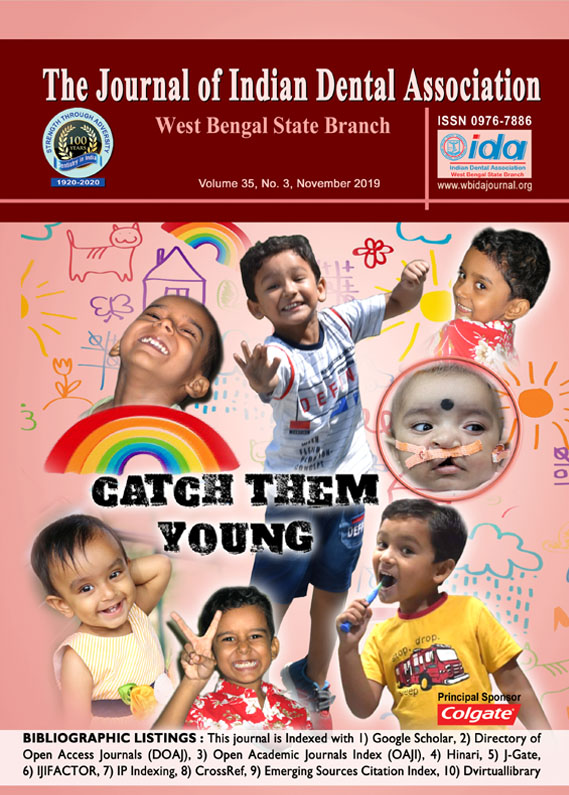Upcoming Events
1. Article Title.
2. Author Details.
3. Abstract.
4. Keywords.
5. Corresponding Author details.
November 2019
Volume : 35
No.: 3

Dr. Aindrila Ghosh,Dr. Paridhee Jalan,Prof. (Dr.) Shabnam Zahir,Prof. (Dr.) Gautam Kumar Kundu
Abstract: Autism spectrum disorder (ASD) refers to a group of neuro-developmental disabilities characterized by impaired social interaction, communication, and restricted or repetitive behavioral stereotypes. Children with ASD are unique in their dietary preferences, dietary habits and oral hygiene habits making them susceptible to dental problems including dental caries. Dental treatment of children with ASD becomes difficult in the dental set up due to their behavioral problems and lack of knowledge on the part of the dental team. Elaborate treatment options should be avoided without general anesthesia in these cases. Considering these factors, application of Silver Diamine Fluoride to prevent further progression of dental caries was done in this case report which also mentions about the dental management of children with ASD.
Dr. Aakansha Malawat,Dr. Debasis Mitra,Prof. (Dr.) Abhijit Chakraborty
Abstract: Idiopathic gingival enlargement is a rare condition of unknown origin. It is a proliferation of fibrous tissue caused by an increase in submucosal connective tissue elements. It is an autosomal dominant condition or very rarely an autosomal recessive mode of inheritance. A 24-year old female patient reported to the Department of Periodontics, Guru Nanak Institute of Dental Sciences and Research, Kolkata, with swelling of gums since 2 years. Orthopantomogram shows generalized bone loss. Scalpel and Electrocautery assisted surgical excision by Ledge and Wedge technique was performed after Phase I therapy. There are various treatment modalities for management of gingival enlargement like external bevel gingivectomy, periodontal flap technique, ledge and wedge technique, etc. Out of these, ledge and wedge technique was selected because it helps in placement of primary incision precisely as opposed to the conventional external bevel gingivectomy procedure. Moreover, this procedure does not leave a large external bevel and therefore results in less postoperative pain and bleeding. The outcome of this surgical procedure was satisfactory in both the treatment modalities, i.e., scalpel and electrosurgery. In addition, there is a need to explain the importance of maintenance of oral hygiene and regular follow up visits to the patients.
Dr. Shubhabrata Roy,Dr. Ankita Tamta,Dr. Samiran Das,Dr. Soumitra Ghosh,Dr. Preeti Goel,Dr. Sayan Majumdar
Abstract: An ocular defect not only affects a person's vision, but also causes severe psychological trauma. An ocular prosthesis improves appearance, increases confidence and enhances social acceptance. But stock eyes are not satisfactory in most situations. A custom made ocular prosthesis provides better adaptation, aesthetics and comfort than a stock one. Polymethyl methacrylate (PMMA) is most commonly used material for ocular prosthesis. Two patients with different ocular defects were treated with acrylic customized ocular prosthesis to provide better quality of life.
Dr. Avik Narayan Chatterjee,Dr. Raju Biswas,Dr. Sauvik Galui,Dr. Subrata Saha,Dr. Subir Sarkar
Abstract: Teeth which are present in addition to deciduous and permanent teeth are called supernumerary teeth. Mesiodens is the supernumerary tooth that is wedged in between the central incisors which may lead to various problems. This case report aims to illustrate the management of rotated maxillary central incisor due to mesiodens by partial fixed ('2 × 4') therapy.
Dr. Niharika .,Dr. Raju Biswas,Dr. Sauvik Galui,Prof. (Dr.) Subrata Saha,Prof. (Dr.) Subir Sarkar
Abstract: Restoration of primary incisors, which have been severely damaged by extensive caries or trauma, is a difficult task for the Pediatric dentist. Primary teeth dictate the physical appearance, and their structural loss leads to compromised aesthetics, mastication, poor phonetics, development of aberrant habits, neuromuscular imbalance, and difficulty in socio- psychological adjustment of the child. This Case Report discusses the restoration of severely decayed primary maxillary incisors using Figaro crowns in a 4 years old male patient.
Dr. Khushboo .,Dr. Bhavya Sharma,Dr. Subrata Saha,Dr. Subir Sarkar
Abstract: Sensory modulation symptoms are common in persons with autism spectrum disorders (ASD); however have a heterogeneous presentation. Many studies have been done indicated a significant high difference between ASD and normal groups of children in the presence/frequency of sensory symptoms, with the greatest difference in under-responsivity, followed by over-responsivity and sensation seeking.It is important to consider these moderators and interventions addressing sensory symptoms. Multisensory environment help in reducing fear and provide important calming effect in such children.
Dr. Satyajit Kundu,Dr. Pari Anand,Prof. (Dr.) Samiran Ghosh,Dr. Abhisek De Sarkar,Dr. Prithwijit Banerjee
Abstract: Aim: The aim of this prospective, study was to compare the anesthetic efficacy of 4% articaine HCl with 1:100,000 adrenaline in comparison with 2% lignocaine HCl with 1:80,000 adrenaline in extraction of mandibular tooth. Materials and Methods: A total of forty patients were included in this study. The onset and duration of anesthesia, pain during injection and extraction, and requirement of rescue blocks were recorded for all patients. The values were compared and analyzed statistically. Results: No statistical differences in induction of both soft tissue and pulpal anaesthesia among the groups. However, highly significant difference was observed in pain during administration as well as pain during operative procedure favouring articaine. Duration of anaesthesia in the post extraction period was also significantly higher with Articaine . Conclusion: In our comparative study showed that 4% articaine had a longer duration of action and more depth of anesthesia when compared to 2% lignocaine. Hence, the pain experienced by the patients during and after the surgical procedure was significantly less.
Abstract: Most microbial ecosystems contain large numbers of genetically distinct microorganisms, and the human mouth is not different. The biofilm communities are complex and dynamic structures that accumulate through the sequential and ordered colonization of multiple oral bacteria. Oral biofilms are characterized by surface attachment, structural heterogeneity, complex interspecies interactions, and an extracellular matrix of polymeric substances, and are high-density micro-niches that differ dramatically from surrounding conditions. Here, it is an attempt to discuss the ecology of oral biofilm.
Abstract: Background: Dental caries is among the most prevalent chronic disease of childhood. Best treatment for a carious tooth is removal of degenerated portion followed by restoration of a suitable material. However, this may not be possible in all cases. So, an alternative approach is to arrest the carious lesion. Silver Diamine Fluoride (SDF) is used to arrest carious lesions particularly in children. Application of SDF is simple and noninvasive. There have been no noted serious side effects of its use. Only disadvantage the discoloration of teeth and mucosa. Current knowledge suggests it can be used for arresting caries in situations where definite treatment is difficult to provide.
Dr. Sanjay Prasad,Dr. Pampa Adhya
Abstract: Conventional complete denture fabrication is a challenge to fabricate in a patient with resorbed ridge and improve the quality of life of a patient .Retention,stability and functional need is difficult to satisfy more in mandibular arch compared to maxillary arch.Implant supported overdenture with various attachment systems are good options to enhance the quality of life of the patient.Of all the attachment available for implant supported overdenture locator system has the lowest profile,universal hinge and easy to fabricate. Patients with mandibular overdentures retained by 2 implants interforaminally had higher satisfaction scores than conventional complete denture patients.
Prof. (Dr.) Amal Kumar Chakrabarti,Dr. Mousum Mondol,Dr. Shresthanu Saha,Dr. Sudipa Meyur,Dr. Vineeth B
Abstract: This case report describes the non surgical, non-extraction therapy of a 13 year old boy with a skeletal Class III malocclusion, a prognathic mandible, and a retrusive maxilla. He was initially classified as needing orthognathic surgery, but he and his parents wanted to avoid that. The Class III malocclusion was corrected with a rapid palatal expander and a maxillary protraction mask followed by non-extraction orthodontic treatment with fixed appliances, combined with short Class III and vertical elastics in the anterior area. The height of the maxillary alveolar process and the vertical face height were slightly increased with treatment. Class I molar and canine relationships were achieved, and the facial profile improved substantially.
Dr. Anubhav Das Adhikari,Prof. (Dr.) Sudip Chakraborty,Prof. (Dr.) Richi Burman
Abstract: Chronic sialadenitis is commonly associated with an acute chronic inflammation and obstruction of the excretory duct. The differentiation between chronic sialadenitis and obstruction of the excretory duct is difficult. The main causes of obstructive disorders are stones in about 60% to 70%, stenosis in about 15% to 25%, inflammation of the duct (sialodochitis) in about 5% to 10%, and other obstructions, such as anatomic variations or foreign bodies, in about 1% to 3%. We report the case of a 56-year-old man who had 3 large submandibular duct sialoliths. We describe the management of this patient and review the literature with emphasis on the various treatment modalities available.
Dr. Pradip Giri,Dr. Indrasri Das,Dr. Tirthankar Debnath
Abstract: Zimmermann Laband syndrome or Laband syndrome or Laband disease (ZLS) is a rare inherited autosomal dominant disease characterised by gingival fibromatosis, hypertrichosis, aplasia or hypoplasia of nails or terminal phalanges of hands and feet. However, the syndromic features of ZLS are highly complicated and variable. This paper, reports a case of ZLS with few manifestations and its dental management.












